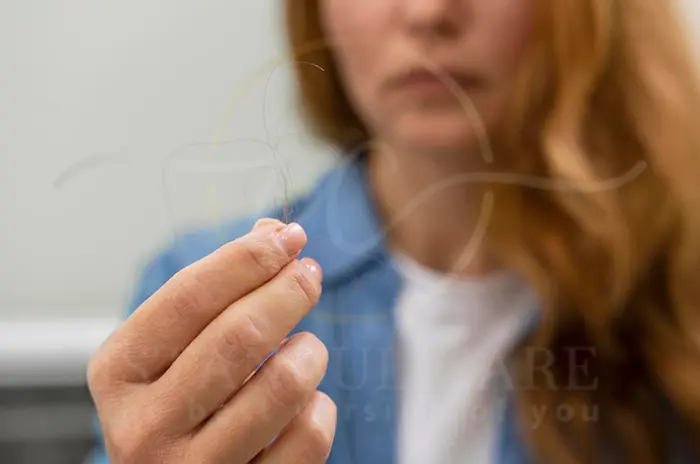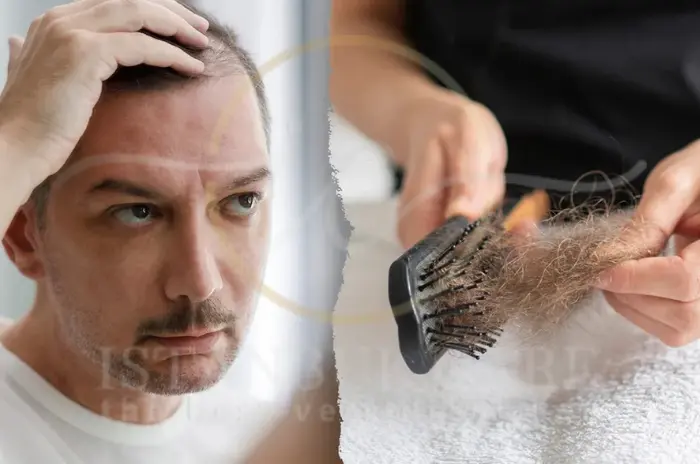Semaglutide (marketed for weight loss as Wegovy and for diabetes as Ozempic) is a GLP-1 receptor agonist that reduces appetite and supports significant weight loss, and is increasingly discussed in relation to Semaglutide Hair Loss. As use grows, many patients ask whether it can cause hair shedding or thinning. The short answer: hair loss has been reported with semaglutide in weight-loss trials, but it appears uncommon and is often linked to rapid weight loss (telogen effluvium) rather than a direct toxic effect on hair follicles.

Does Semaglutide Hair Loss Occur?
- Regulatory data: In adult Wegovy trials, alopecia occurred in ~3% on semaglutide vs ~1% on placebo; in adolescents, ~4% vs 0%. These frequencies are below 5% (i.e., not “common”) but higher than placebo.
- Drug labels/assessments: European regulators list hair loss as an identified adverse event and note new AEs (including hair loss) during assessment; the Canadian product monograph reports higher alopecia rates in people who lost ≥20% body weight (5.3% vs 2.5%), implicating weight-loss magnitude as a driver.
- Diabetes-only data: Ozempic’s diabetes studies did not report alopecia as a labeled side effect, though post-marketing reports exist. This again points toward weight-loss context as the main factor.
- Comparators: Hair loss has also been seen with other weight-loss agents (e.g., tirzepatide ~4–5% vs ~1% placebo), supporting the idea that rapid weight reduction and nutritional shifts may trigger shedding across drug classes.
Bottom line: Semaglutide can be associated with hair loss, but most evidence suggests indirect mechanisms related to weight-loss physiology rather than a direct follicle toxin.
Mechanisms Behind Semaglutide-Induced Hair Thinning
| Mechanism | Why It Happens on Semaglutide | Typical Pattern | Expected Course |
|---|---|---|---|
| Telogen Effluvium (TE) | Caloric deficit/rapid weight loss shifts hairs prematurely into resting (telogen) phase | Diffuse shedding 2–3 months after a trigger | Usually self-limited once weight and nutrition stabilize (months) |
| Micronutrient Gaps | Lower intake and appetite suppression → iron, zinc, protein, vitamin D shortfalls | Diffuse thinning; weak shafts | Improves with repletion and adequate protein/iron |
| Endocrine Shifts | Improved glycemia, thyroid changes, stress–cortisol dynamics during rapid loss | Mixed (diffuse; may unmask pattern loss) | Normalize underlying issue, add standard hair therapies as needed |
| Unmasking Androgenetic Alopecia (AGA) | As density drops globally, underlying genetic pattern becomes more visible | Men: hairline/crown; Women: part-line widening | Treat per AGA algorithms (minoxidil, anti-androgens where appropriate) |
How Semaglutide May Trigger Hair Shedding
- Energy deficit & stress signal: Rapid fat loss is a physiologic stressor; hair follicles “pause” growth (TE). Shedding often starts 8–12 weeks after the largest caloric shift.
- Nutrient intake drops: Appetite suppression can lower protein, iron/ferritin, zinc, and vitamin D, all critical for anagen maintenance.
- Weight-loss magnitude matters: Analysis in the Wegovy monograph shows more alopecia in those losing ≥20% of body weight, reinforcing a dose-response with weight loss, not necessarily the molecule itself.
- Heterogeneous evidence: Observational studies conflict—some show increased risk vs another drug, others do not show a significant signal. High-quality trials focused on hair are still needed.

Managing Hair Loss While Using Semaglutide
At İstanbul Care intermediary organization, our approach focuses on maintaining the benefits of semaglutide while protecting hair health.
1) Optimize Weight-Loss Pace & Nutrition
Target gradual loss after the initial phase; avoid extreme deficits.
Protein: ~1.0–1.2 g/kg/day; consider 1.2–1.5 g/kg during more aggressive phases.
Micronutrients: Check ferritin (aim >40–70 ng/mL if symptomatic), vitamin D, zinc, B12; replenish as needed.
Balanced plan: Include omega-3s, colorful vegetables, and sufficient calories to support healthy hair cycling.
2) Evidence-Based Hair Therapies
Topical Minoxidil 2–5% once daily (men & women): prolongs the hair growth phase; expect visible changes in 3–6 months.
Low-Level Laser Therapy (LLLT): home devices 3–4x/week can support density over 3–6 months.
PRP (Platelet-Rich Plasma): treatment series over 3–6 months for miniaturizing follicles.
Treat underlying patterns: If androgenetic alopecia is unmasked, discuss finasteride/dutasteride (men) or spironolactone (women, if appropriate).
Specialist input: Seek dermatology evaluation if shedding is severe, scarring is present, or the diagnosis is unclear.
3) Gentle Hair-Care Routine
Avoid tight hairstyles, traction, high-heat tools, and harsh chemicals.
Use mild shampoos; consider gentle scalp massage 3–4 minutes/day.
Protect hair from UV and chlorine; manage scalp conditions like seborrhea with the right shampoo.
4) Tracking & Reassurance
Take baseline photos (front, sides, crown) and repeat every 12 weeks.
Set expectations: Telogen effluvium often peaks over several weeks, then subsides as triggers resolve; full cosmetic recovery may take 6–12 months.
How Often Does Hair Loss Happen with Semaglutide?
| Population / Source | Semaglutide (Wegovy) | Placebo | Notes |
|---|---|---|---|
| Adults (obesity trials) | ~3% alopecia | ~1% | Below 5% but higher than placebo; observed in trials |
| Adolescents (≥12 years) | ~4% alopecia | 0% | Pediatric signal observed |
| High weight-loss subgroup | 5.3% (≥20% loss) | 2.5% (<20% loss) | Greater loss with larger weight reductions |
| Ozempic (T2D indications) | Not on label | — | Case reports exist but not documented in diabetes trials |
| Tirzepatide (comparison) | 4–5% | ~1% | Suggests a possible class/weight-loss effect |
Context: Available evidence suggests that hair loss on semaglutide is uncommon and likely related to weight-loss mechanisms rather than a direct drug effect.
What Might Explain Hair Shedding on Semaglutide?
- Rapid caloric deficit → telogen effluvium (a temporary shedding phase).
- Nutrient levels drop below hair growth thresholds (iron/ferritin, zinc, protein, vitamin D).
- Physiologic stress from rapid body-composition changes.
Unmasking of pre-existing pattern hair loss as overall density decreases.
Speak with our expert Hair Transplantation specialists

Speak with our expert Hair Transplantation specialists
We’re ready to answer your questions
Frequently Asked Questions
When choosing a shampoo, consider your hair type and concerns. If you have dry hair, opt for moisturizing shampoos. For oily hair, choose clarifying or volumizing shampoos. If you have a sensitive scalp, look for gentle, sulfate-free shampoos.
Foods rich in protein, vitamins (A, C, E), and omega-3 fatty acids are great for hair health. Include eggs, fish, nuts, seeds, and leafy greens in your diet to promote strong, shiny hair.
For most hair types, washing your hair 2–3 times a week is sufficient. Washing too frequently can strip your hair of its natural oils, while infrequent washing can lead to product buildup.
A good daily hair routine includes shampooing and conditioning (2–3 times a week), using a lightweight hair oil, and protecting your hair from heat styling. Regularly massage your scalp to promote circulation and keep your hair nourished.

